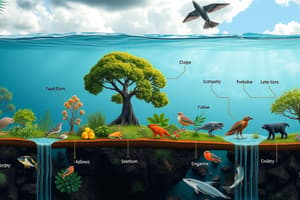Podcast
Questions and Answers
What primarily drives the interactions within an ecosystem?
What primarily drives the interactions within an ecosystem?
- Universal forces of matter and energy (correct)
- Geographical barriers
- Human influence
- Natural disasters
Which of the following is NOT a function of the production process in an ecosystem?
Which of the following is NOT a function of the production process in an ecosystem?
- To absorb pollutants from the air (correct)
- To produce biological productivity
- To provide food for herbivores
- To impact environmental conditions
In a food chain, what do primary consumers primarily feed on?
In a food chain, what do primary consumers primarily feed on?
- Abiotic factors
- Decomposers
- Other consumers
- Producers (correct)
What distinguishes a food web from a food chain?
What distinguishes a food web from a food chain?
Which organisms are key players in decomposition processes?
Which organisms are key players in decomposition processes?
Which of the following is a biotic component of an ecosystem?
Which of the following is a biotic component of an ecosystem?
What role do herbivores play in an ecosystem?
What role do herbivores play in an ecosystem?
In ecological terms, bioaccumulation refers to:
In ecological terms, bioaccumulation refers to:
Which is NOT an example of a forest fire's impact on ecosystem processes?
Which is NOT an example of a forest fire's impact on ecosystem processes?
What do energy flows through ecosystems mainly indicate?
What do energy flows through ecosystems mainly indicate?
Flashcards are hidden until you start studying
Study Notes
Energy Flow in Ecosystems
- Energy input in ecosystems is measured in Joules or calories, also known as calorific flow.
- Lindeman's energy flow model describes the energy dynamics in lake ecosystems, expressed in units of gcal/cm²/yr.
Ecological Pyramids
- Ecological pyramids graphically represent the trophic structure of ecosystems.
- Each trophic level corresponds to a feeding position in food chains: primary producers, herbivores, carnivores, etc.
- Types of ecological pyramids include pyramids of number, biomass, and energy.
Balance of Ecosystems
- Ecosystems operate as open, interconnected systems with multi-dimensional interactions.
- Various levels contribute to ecosystem balance:
- Individual level fosters self-sustaining responses.
- Population level maintains density through biological interactions.
- Community level emphasizes ecological relationships among species.
- Ecosystem level involves adjustments in functional processes like production and decomposition.
Ecosystem Concepts
- An ecosystem is a collection of organisms interacting with each other and their specific environmental factors, exchanging energy and matter.
- Most ecosystems are relatively self-contained and require material exchange.
Components and Structure
- Abiotic components include physical (climate, terrain), inorganic (gases, minerals), and organic factors (vitamins, proteins).
- Biotic components encompass:
- Producers: Crucial for ecosystem existence and diversity.
- Consumers: Affect biodiversity and help maintain ecological balance.
- Primary consumers: Herbivores.
- Secondary consumers: Carnivores.
- Tertiary consumers: Omnivores.
- Decomposers: Essential for nutrient cycling and ecosystem maintenance.
Functional Processes
- Ecosystem functions arise from interactions between biotic and abiotic components, driven by matter and energy.
- Production Processes:
- Photosynthesis in green leaves produces food, while roots absorb nutrients.
- Herbivores consume plant production, serving as prey for carnivores.
- Decomposition Processes:
- Non-biological mechanisms include events such as forest fires.
- Biological mechanisms involve saprophytes and waste-eating organisms like bacteria, fungi, and small animals.
Food Chains and Food Webs
- Food Chains: Represent unidirectional energy flow; energy is transferred from producers to consumers.
- Trophic levels include producers and various types of consumers and decomposers.
- Food Webs: Illustrate interconnected food chains and complex feeding relationships, highlighting multiple food sources and predator-prey interactions.
Significance of Food Chains and Webs
- They define the nutritional structure and diversity of ecosystems.
- They play critical roles in regulating ecosystem balance.
- Highlight ecological concerns, including the sensitivity of ecosystems and issues like bioaccumulation of pollutants.
Studying That Suits You
Use AI to generate personalized quizzes and flashcards to suit your learning preferences.




